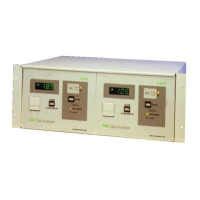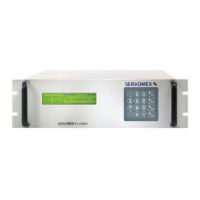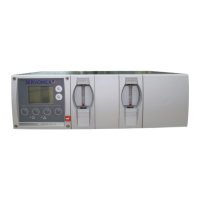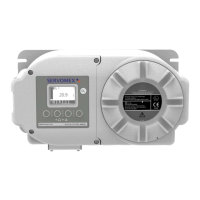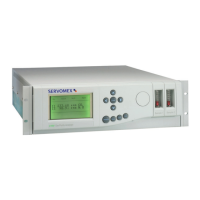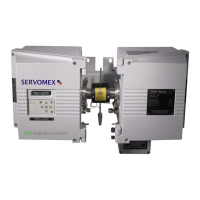3.27
Note: For auto-calibration to operate the oxygen content of the Span gas must be at least
10% greater than the oxygen content of the Zero gas.
The oxygen signal during the auto-calibration sequence is shown in Figure 3.3. At the start of
auto-calibration the analyser measures and stores the oxygen content of the sample gas.
If the oxygen reading is greater than ±3% of the zero gas value (as stored in parameter no. 97)
then zero gas is turned on. There is a short distance velocity (DV) lag before the oxygen
reading changes towards zero gas. If there is no change in oxygen signal during a certain
preset time, the auto- calibration sequence will be aborted since the analyser will assume that
zero gas is not flowing. When the oxygen value is within 3% of the zero point the span gas is
turned on.
With software 0110066X if the sample gas value is within ±3% of the zero gas value then span
gas is turned on directly.
There is a DV lag and the analyser searches for the end of this lag indicated by a change in
oxygen signal. If a change is not detected within a certain time the analyser will abort the
auto-calibration sequence and will return to the sample gas without automatically re-calibrating.
The 90% point is searched for and if it is not reached within a pre-set time the auto-calibration
is aborted and the analyser returns to sample. If the 90% point is detected the analyser will
measure the oxygen reading every 15 seconds (this time is user adjustable to tune the
accuracy). When two consecutive readings are identical the analyser will store that as the span
calibration point.
If a stable reading is not obtained within a preset time auto-calibration is aborted.
Note: The analyser only stores this reading at this stage, it does not re-calibrate the span.
Zero gas is turned on and the analyser searches for the DV lag and the 90% point, again
within preset time intervals, and if the oxygen signal does not reach that point within these
times then the analyser will again abort the sequence. If the 90% point is detected the analyser
will search for a plateau by measuring the oxygen reading every 15 seconds (user adjustable)
and will compare consecutive readings. When two readings are identical the analyser assumes
the plateau has been reached and stores that oxygen reading as the zero calibration point.
Again, if a stable reading is not obtained within a preset time auto-calibration will be aborted.
Note: The analyser at this stage has not yet re-calibrated.
Sample gas is turned on. After a time interval which is user settable, the analyser recalibrates
and the analogue output becomes live (if it was previously frozen). With software 0110066X,
the end of auto-calibration is when two sample gas readings are obtained which are within
0.5% O
2
of each other.
